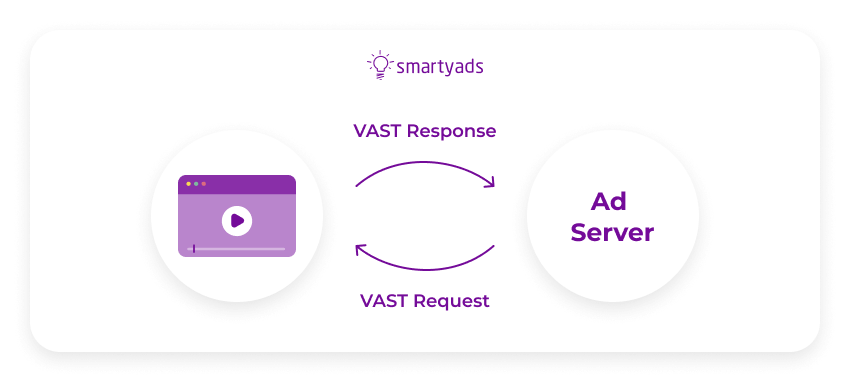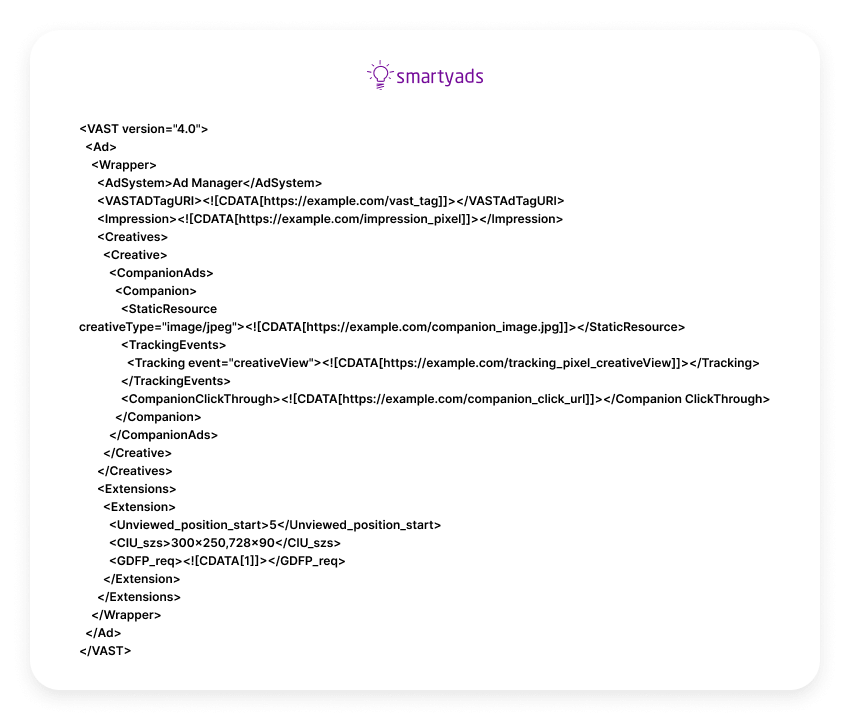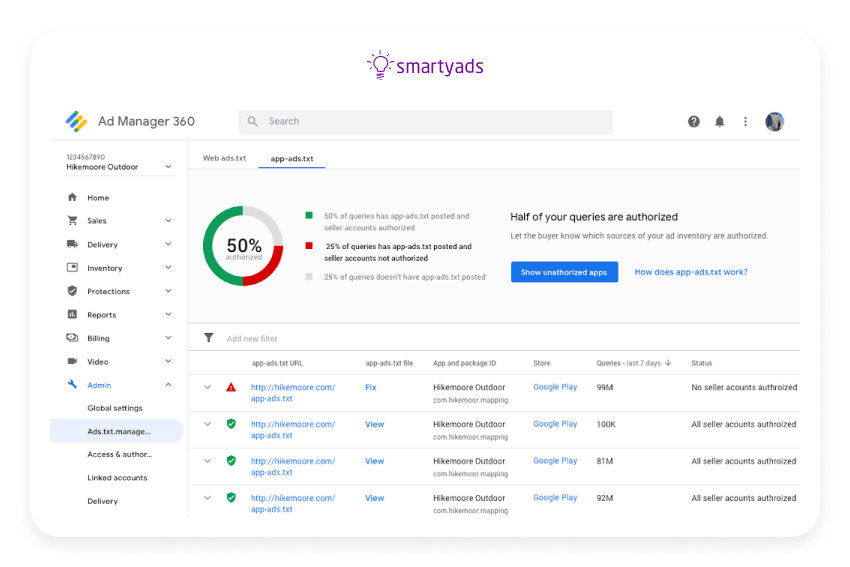Video advertising has become crucial for every company seeking to expand.
According to a study, ad spending in video advertising will hit $176.6 billion in 2023 before climbing to $229.8 billion by 2027.
Many businesses use programmatic video advertising to drive their income.
You should know about VAST tags if you want to deliver video ads to the relevant audience at the right time and on the right device. They provide publishers and advertisers with enhanced control over the video advertisement experience.
So, let's focus on the main features of VAST tags.
What is Video Ad Serving Template (VAST)?
VAST serves as a template that organizes ad tags, enabling the delivery of video and audio ads to media players. VAST transfers essential metadata about an advertisement from the ad server to the media player using an XML schema.

Video Ad Serving Template provides comprehensive instructions to the video player regarding the ad's timing, retrieval, rendering, and essential details, such as pricing.
Moreover, VAST can incorporate tracking pixels, enabling efficient tracking of multiple metrics alongside the video content.
What is a VAST Tag?
The VAST tag serves as a third-party ad script written in XML and created by an ad server to show video ads.
This compact code snippet is vital in executing the entire ad delivery process. It contains crucial information about the ad, like its duration, video format, destination URLs in the ad server, etc.
Each VAST tag contains different parameters that change according to the needs of the publisher and advertiser.
Integral Elements of a VAST Tag
Let's review the key elements in a VAST tag.
Media file
Every VAST tag includes a link to the media file that contains the ad creative. It specifies the URL where the media file can be downloaded or provides attributes for generating a link to the ad server.
In other cases, attributes are specified, and a link to the ad server for the creative is generated.
Video format
The VAST tag also includes the video ad format like a flash or MP4 video. This information helps the video player understand the compatible video format required for seamless playback.
Tracking
VAST tags include tracking mechanisms to measure the effectiveness of the video ad. Typically, the URL to a media file on the ad server is included in the VAST tag.
When contact is made, a tracking pixel records the impression and other relevant information.
VAST Tag Example
Below is the complete example of a VAST tag with elements like unviewed_position_start, ciu_szs, and gdfp_req.

These elements define delayed impressions for the video, a list of companion sizes, and indicate the user's presence on the Ad Manager schema.
The tag also includes additional elements such as impression tracking pixels, ad creative assets, and companion ads to provide a comprehensive ad experience.
Different Ads that can be Displayed using VAST Tags
Overlays
They appear as text or image fragments above the primary video and flow perfectly with it without pausing the ad playback.
Inline ads
Inline ads are delivered via the VAST protocol containing all necessary components. Therefore, the video content improves the visual experience of the advertisement.
Joint banners
Joint banners are shown on a website. Typically, they begin when specific things happen, like a mouse hover.
Companion ads
These ads are display advertisements, text, or rich media that appear around or alongside the video player.
Benefits of VAST Tags
Video Ad Serving Template assists video players and ad servers in interacting with each other for a seamless display of video ads.
Some key benefits of utilizing VAST tags include the following:
- The VAST protocol provides advertisers, video player developers, and producers with a common communication language for executing and serving digital video ads;
- For advertisers, it reduces playback errors and provides solid control of how they want video ads to be tracked and displayed;
- For publishers, it saves time and money on training, developing, and managing customized video ads for multiple servers and networks.
How Does VAST Tag Work?
Understanding the functioning of VAST (Video Ad Serving Template) tags within websites involves a three-stage ad insertion process. Let's explore each stage:
1. VAST request.
The video player initially delivers a request to the ad server to get the video ad. This request contains information about the available ad slots, ad formats, and targeting criteria.
2. VAST inline response.
Once the ad server receives the request, it provides an inline response to the video player.
This response includes the video media file necessary for showing the ad and the essential tracking URLs.
3. URL tracking.
The video triggers pixel and URL tracking mechanisms, facilitating the collection of metrics by both parties involved. These metrics include impressions, clicks, views, and other engagement data.
Marketers can gather valuable data to assess and optimize the video ad campaign performance by leveraging pixel and URL tracking.
![]()
VAST Tag: a Brief History of Video Advertising Standard
To meet the growing demand for video content, the Interactive Advertising Bureau (IAB) introduced the initial version of VAST, namely VAST 1.0, in 2008.
VAST 1.0 provided essential tracking functionalities and supported popular video formats like MP4, 3GP, and MOV.
Over time, as the demand for video advertising surged and video player technologies advanced, VAST underwent several upgrades. The latest version, VAST 4.0, was launched in June 2018 as a result of these continuous improvements.
VAST 4.0 introduced multiple advertisement possibilities, including separate video and interactive files, ad server stitching, viewability, verification, and detailed reporting.
VAST vs. VPAID: choosing the best
To simplify the process of displaying ads, The Interactive Advertising Bureau (IAB) has introduced a standardized ad response format.
Therefore, advertisers don't need to fret about the video ad failing to launch on a specific player, and publishers shouldn't have issues with limited compatible demand. The name of the template was VAST, which is an abbreviation for Video Ad-Serving Template.
As the digital advertising industry evolved over time, the issue of converting video advertisements to a more interactive format arose.
As a result, the IAB developed VPAID, which stands for Video Player Ad Interface Definition and was designed to handle complex ad units requiring on-page logic.
VPAID overlays VAST to enable complex advertising experiences and improve user analytics.
Therefore, a VPAID advertisement is basically a fragment of JavaScript code contained within a VAST container that interacts with video players compatible with the format.
VPAID (video player ad interface definition) assists video players in synchronizing with video ad networks and enables marketers to serve interactive and rich media advertisements.
So, VPAID has two major advantages over the standard VAST video script: measurement and interactivity.
Moreover, VAST is for your vastly vanilla type of creatives, whereas publishers who adopt VPAID will be compensated because their video players will be able to accept more ad types.
For example, VPAID enables a viewer to click on a pre-roll to learn more about content. Through VPAID tags, a brand can serve the same video ad in Boston and New York City while displaying different offers at the end of the ad to viewers in the two cities.
However, VPAID is more prone to errors, may have compatibility issues with certain video players, and is more difficult to set up.
VAST compensates for its lack of diversity with its stability and simple usage. If you utilize services such as Google Ad Manager, you won't even need to manually create VAST tags, as the procedure is almost entirely automated.
How to Create a VAST Tag?
Although creating a VAST tag is a relatively straightforward process, there are several methods to do so.
Generate VAST Tags in Google Ad Manager
Google is one of the leading ad servers for generating VAST tags. It simplifies the process and supports HTTP and HTTPS URLs.
With the specific Google Ad Manager account, you can create a VAST tag in a few simple steps:
- Access your Google Ad Manager account;
- Navigate to the ad inventory section;
- Locate the specific Ad Unit where you want to generate the VAST tag;
- Click on the Ad Unit and select the "Tags" option;
- Fill in the relevant data required for the VAST tag;
- Copy the generated ad tag provided by Google Ad Manager.

While Google is the famous ad server for creating VAST tags, advertisers have the flexibility to utilize any ad server that is VAST compatible. It's important to note that the chosen video player should support all the necessary VAST specifications to ensure seamless integration and avoid any potential mistakes.
Generate VAST Tags With Third-Party Tools
- Select a reputable VAST tag generator. Ensure that the chosen tool supports the necessary VAST specifications;
- Follow the instructions provided by the tool;
- Copy the generated VAST tag.
Create VAST Tags Manually
You can create the VAST tag manually if you don't use Google Ad Manager and third-party tools.
You should do the following:
- To create VAST tags manually, you should have a basic understanding of XML;
- Define the required parameters and values for the VAST tag;
- Use an XML editor or a simple text editor to create the XML file;
- Input the necessary elements, such as media files, video formats, and tracking URLs;
- Save the file with the ".xml" extension;
- Copy the content of the XML file to obtain the manually created VAST tag.
How to Validate VAST Tags
It's crucial to validate all VAST tags to ensure they are bug-free. Marketers can select from a variety of validators for VAST tags.
Review the most common validators listed below:
Video Suite Inspector
To ensure your VAST tag's compatibility with the IMA SDK for HTML5, use Google's Video Suite Inspector. It efficiently checks the functionality and performance of your VAST tag.
Moreover, marketers can evaluate their VAST tags with only one click!
IAB's VAST Tag Validator
Another solid VAST tag validator is Interactive Advertising Bureau VAST Tag Validator. It supports VAST 2.0, 3.0, and 4.0 and enables marketers to test required nodes and attributes under different scenarios.
YouTube Vast Validator
If you plan to serve video ads on YouTube, you can rely on the YouTube VAST Validator. It ensures that your VAST ad tags meet the requirements for third-party video ads on the platform.
Best Practices for Boosting VAST Ads
- It is crucial to copy and paste the VAST code without any mistakes. Take the time to double-check the VAST code carefully before implementation;
- Additionally, it is important to have enough video content to serve users. Placing ads without relevant video content reduces their purpose and effectiveness;
- If you are already running multiple ad formats, consider how they will work together to avoid ad oversaturation. You can conduct tests and closely monitor clicks and views;
- Remember to generate a unique ad code for each website where the VAST code will be implemented.
Conclusions
A VAST tag is a must-have tool when you put a video into your advertising strategy.
Using VAST tags, publishers can effectively monetize their video content by delivering targeted ads to their audience, while advertisers can precisely target the right audience and track the performance of their video ad campaigns.
Therefore, implementing video ads with VAST tags will improve video ad performance on all websites.
Run video ad campaigns using VAST tags together with SmartyAds DSP!




